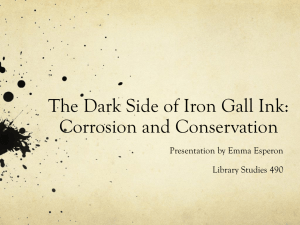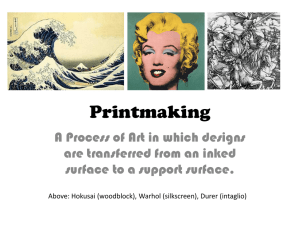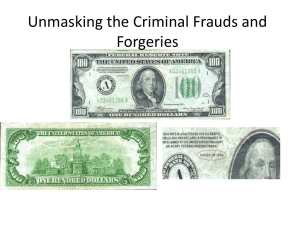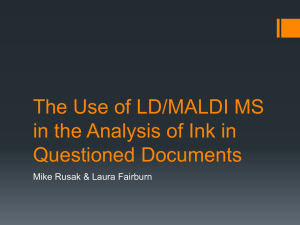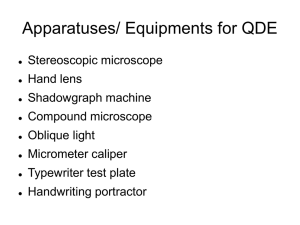Caitlin LaClair, Reduction of Hazardous Waste in Fluid Ink
advertisement
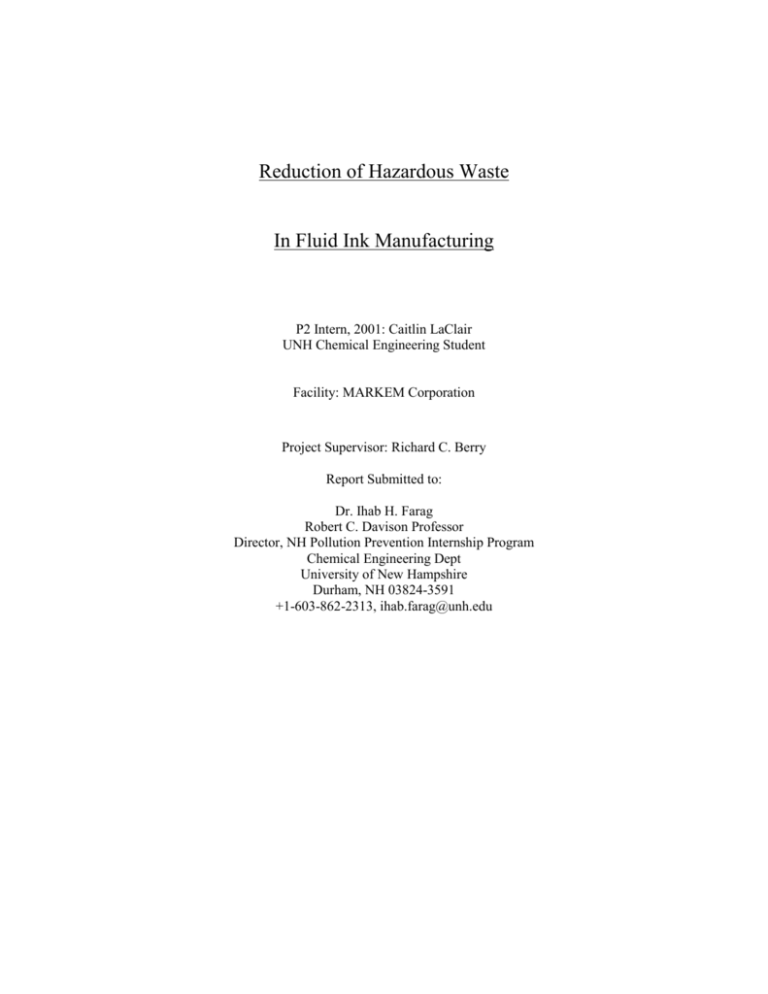
Reduction of Hazardous Waste In Fluid Ink Manufacturing P2 Intern, 2001: Caitlin LaClair UNH Chemical Engineering Student Facility: MARKEM Corporation Project Supervisor: Richard C. Berry Report Submitted to: Dr. Ihab H. Farag Robert C. Davison Professor Director, NH Pollution Prevention Internship Program Chemical Engineering Dept University of New Hampshire Durham, NH 03824-3591 +1-603-862-2313, ihab.farag@unh.edu Table of Contents 1. Executive Summary 2. Introduction/Background 3. Goals/ Objectives 4. Approach/ Methods 5. Project Findings/ Details of Work Accomplished a. Overview b. Materials Not Meeting Specifications c. Excess Ink d. High Yield Inks e. Inconsistent Records 6. Recommendations/ Pollution Prevention Benefits a. Excess Ink b. Solvent Use c. Proper Measuring and Handling d. Expired Inks 7. References (superscripts throughout the document refer to the corresponding reference number) 8. Appendices A. Percent Excess Ink Determination for Small, Medium and Large Mill Batches. B. Percent of Finished Ink Discarded and Weighted Percent Excess per Week. Executive summary Reducing the hazardous waste generation in the production of fluid ink has pollution prevention and money saving benefits. In addition to demonstrating environmental awareness, hazardous waste reduction puts more money into valuable product and less into disposal fees, raw materials and labor and equipment costs. The objective of this project was to determine how much hazardous waste is generated in the production of fluid ink, the source of this waste, and possible waste reduction solutions. Through data collected on the manufacturing floor as well as from waste records, waste streams were identified. The following table summarizes the findings of this project. Table 1. Selected Hazardous Waste Weight and Calculated Volume Percent per Month Waste Source Percent Percent Weight Volume % % Material Not Meeting Specs. 25 25 Excess Ink Waste 25 24 Spent Solvent and pumpable liquids 22 23 Solvent Sludge 18 18 Expired Raw Materials 8 8 Expired Ink 2 2 The recommendations to minimize waste were made for the greatest volume (and cost) contributors. The suggestions in the following areas include: Excess Ink Investigate custom ink formulas to ensure correspondence between desired and actual ink yield. Adjust known formulas of known custom inks which consistently yield more than intended. Investigate the possibility of reducing the volume of ink retained for quality control. Reduction or Recovery of Solvent Investigate filters to extend solvent life in parts washers. Consider putting a plunger can in the base making room to reduce use and spills. Use a dry rag to remove as much ink as possible from equipment before using solvent. Accurate Measuring and Proper Waste Handling Investigate methods to reduce excess in make ready such as digital dispensing systems or adjustable tables to hold scales. Emphasize the importance of reserving hazardous waste space for hazardous waste only. Expired Ink Donate expired ink to artistic departments at schools or other organizations or find another market that could use the expired ink. Introduction/ Background Reducing hazardous waste generation most obviously reduces disposal fees. Further, because each step in the production process impacts the final product, waste reduction has the potential to save costs throughout the manufacturing process. From a financial point of view, reducing waste means investing more money in marketed goods, and less in costly waste, and that is the bottom line. Finding the cause of waste and quantifying it illustrate the most detrimental problems and bring attention to areas offering clear pollution prevention opportunities. To this end, observations began on the manufacturing floor, where the ink production process was followed. The ink manufacturing process involves three main operations including mixing, milling, and packaging. The components of the ink are mixed and depending on the batch size and characteristics of the ink, it is milled on a small, medium, or large mill. After milling, the viscosity is tested and adjusted until it falls into a specified range. Upon approval from quality assurance, the ink is packaged by pouring it manually from plastic buckets into containers. Once the order is filled, the excess ink is discarded or packaged- depending on whether the ink is custom made or regularly stocked, respectively. Goals/ Objectives The product of this ten-week project was to perform an analysis of the hazardous waste generated and to offer suggestions to help reduce hazardous waste. The four objectives were as follows: 1) To identify and quantify the tasks which cause hazardous waste; 2) to determine the operational source of hazardous waste causing the greatest volume and cost; 3) to make waste reduction suggestions for these sources; and 4) to recommend further study in areas with waste reduction opportunities. Approach/Methods Opportunities for hazardous waste reduction were greater in some areas than others. For example, there were more pollution prevention opportunities in reducing wasted ink than in reducing wasted solvent, as the company installed a still and recovers spent solvent. The necessary data to identify and quantify waste steams was collected and analyzed. The analysis focused on the waste streams with the highest volume. The information gathered during the first few weeks included several flow diagrams illustrating the ink lost and wastes associated with each batch of ink followed. Computer data bases used include the MRP system and Production History. The MRP system was used to find the costs at different stages in manufacturing, the volume of ink on the work order receipt vs. the volume of ink received into finished goods inventory, and the volume of certain inks discarded because of expiration. The Production History database was used to determine the total volume of inks on the work order receipts and the number of batches made over a period of time as well as the volume of materials that did not meet specification in 2000. Data gathered from individuals in the company was used in the overall waste generation diagram describing the operation of the solvent still, the solvent/ink retention in cloth wipers, and the determination of high yield inks. Waste records such as the hazardous waste inventory of 2000 and waste manifests were used to produce this diagram as well. The compilation of these sources allowed flow diagrams quantifying hazardous waste streams to be produced. The waste streams were analyzed with priority given to those responsible for the highest volume. A number of suggestions result from this analysis. Project Findings Overview About 40% of the total hazardous waste cost results from cleaning operations, base making debris, excess and expired flammable ink, and all process waste. However, non-flammable excess and expired ink, accounts for 25% of the disposal cost of hazardous waste. Table 1a. Breakdown of Hazardous Waste for 2000 (*Top Three Highest Volume Contributors) Source % Total Cost % Total Volume 9% 6% Inventory Resins etc. 8% 4.8% Cleaner 1% 1.0% 91% 94% Manufacturing Dye (from Exhaust System) 7% 9% *Non-pumpable flammable waste 43% 51% *Spent solvents and pumpable liquids 15% 17% *Non-pumpable, Non-Flammable 25% 15% waste oil 1% 2% Total 100% 100% Table 1b. Explanation of Waste Included Top Three Volume Contributors Waste Flammable Flammable Characteristics Non-Pumpable Pumpable Specific -Excesses in make ready(flam) -Excesses in Components -Excess ink (flam) make ready Included -Expired ink and materials (flam) -Spent or expired -Scrapped ink (flam) liquids -Solvent Sludge from distillation unit -Acetone drenched paper wipes -Base filters and resin debris Non-Flammable Non-Pumpable -Excess ink -Expired ink -Scrapped ink Figure 1 shows the waste resulting from each operation and figure 2 shows the percent contributions on each type of waste in fluid ink inventory and manufacturing on the basis of a year. The manufacturing wastes include excess ink waste, acetone drenched paper wipes, cleaning waste, and expired goods. The costs determined from the waste manifests include only the disposal costs of waste. To gain a clearer perspective of the total cost of hazardous waste generation, all costs associated with excess discarded ink were determined. As illustrated by Table 1b, the top three volume contributors in Table 1a are comprised of many components. Therefore, in order to make specific waste reduction suggestions to the most important areas, detailed information about the components making up the pumpable and non-pumpable flammable and non-pumpable, non-flammable wastes was explored. Table 1c shows the weight percent and volume percent of the components of many of these components. The table is listed in descending volume and weight percents to `emphasize the order of importance in waste reduction. The findings to support the information presented in Table 1c follow in this section. Table 1c. Selected Hazardous Waste Weight and Calculated Volume Percent per Month. Waste Source Percent Percent Weight Volume % % Material Not Meeting Specs. 25 25 Excess Ink Waste 25 24 Spent Solvent and pumpable liquids 22 23 Solvent Sludge 18 18 Expired Raw Materials 8 8 Expired Ink 2 2 Material Not Meeting Specifications The materials that fall outside of the specified range contributed the greatest weight to the waste generated in 2000. Efforts to reduce this waste are currently in place and the number of batches of ink that do not meet specification is declining. In 1999, an average of eleven batches of ink was discarded per month due to materials not meeting specifications. To date in 2001, an average of three batches of ink has been discarded per month. By increasing the training of personnel and making changes in some of the ink formulas, the number of batches of ink that do not meet specifications has decreased. Efforts have produced a 73% reduction in number of batches discarded in the past three years. Excess Ink Waste Four batches of ink were followed from make ready to packaging, recording all hazardous waste associated with the process (figure 3,). The greatest and most obvious source of waste was the excess ink discarded upon completion of a custom ink order. Because the ink that was discarded at the end of the packaging process immediately stood out as an area that might be improved, more data was collected on excess ink. The excess ink for each batch produced during a two-day period was recorded. This percentage was based on the total raw materials added including viscosity adjustments. From this data the average percent of excess ink produced from small, medium, and large batches was determined. The cost of production and disposal of excess ink was determined using the MRP system (Appendix A). Table 2. Ink Loss for Small, Medium and Large Ink Batches Quantity Small Mill Medium Mill Large Mill Determined (16-128 oz) (129-500oz) (501-3800 oz) Percent loss (%) 11.62 6.02 1.32 Averages 6.32 In order to estimate an average weighted percent excess for a week, the ink production from November 13th-17th was grouped into three categories: small, medium, and large batches (Appendix B). By relating the cumulative volume for small, medium, and large batches (including viscosity adjustments) to the percent excess found for small, medium, and large ink batches, respectively, the total amount of excess ink produced for the week was calculated to be about 3%. To verify the credibility of this value, the production from November 13-17th was examined using another method. Table 3a. Weighted Percent Excess Based on 103 Batches in Week of November Using Table 1 Small Medium Large Total Mill Mill Mill Wgted % Excess 1.2 1.1 1.0 3.3% The cumulative batch sizes from the work order receipts were compared to the volume of additions to adjust the viscosity. It was found that an additional 8% of the cumulative batch size was added in viscosity adjustments (Appendix B). From this information, the theoretical amount of ink produced in 2000 was determined. The theoretical volume of ink produced was compared to the volume of ink received into inventory and it was found that about 5% of the ink did not reach inventory. Thus 5% excess ink was made according to this method. Because neither of these methods could be proven to be more or less accurate than the other, they were combined to estimate the total percent excess for 2000. With an estimate of 3.3% excess from one method and 5.2% from another, the average percent excess for 2000 was estimated to be 4.2±1.0%. The volume of excess calculated was based on the finished ink quantity report for 2000 9. The four ounces retained for each batch of ink produced adds up to over 200 gallons per year. After a year, the retained ink is discarded. At one time, a smaller volume of ink was retained, one ounce per batch. However, more ink was needed to get an accurate viscosity reading with the viscometer used. Discarding excess ink includes the cost of disposal, waste management, raw materials, equipment use and labor; therefore, to portray the total cost of excess ink, both production and disposal must be taken into account. In addition, the cost of excess ink increases through each processing step. When ink is discarded at the packaging stage, it has already been mixed, milled, and adjusted to the correct viscosity. As more time and labor are spent on the ink, the monetary investment in the excess ink waste grows. Inks Bearing High Yield When the actual yield is consistently above the yield indicated on the work order receipt (figure 4), the ink can be classified as high yield. In some cases, ink requires additional thinner or body agent to attain the correct ink viscosity. For these inks, the yield is greater than intended because of the excess thinner or body added. However, some inks are intrinsically high yield, that is, no thinner or body is added and still the yield is high. Ten high yield inks have been identified 1 using the MRP system and examining the inks discarded due to expiration of shelf life. In the case of a well selling, stocked ink, high yield does not equate to wasted ink because it is packaged, sent to the stockroom, and in most cases sold before it reaches the end of its shelf life. However, for custom inks, high yield is the cause for creating excess wasted ink. Inconsistent Records A possible reason that the problem of excess ink exists may be that records are inconsistent. The volume of ink transferred to inventory vs. the volume of ink specified on the work order receipts for the year 2000, appears to be inconsistent within the MRP system. The volume of ink on the work order receipts accounts for a four ounce retain and ink lost to the equipment, thus the amount of ink transferred to inventory should have been consistently less than that on the work order receipts. However, it was found that for the week in November about 3% more ink went into inventory than was specified on the work order receipts, and for the year 2000, about 2% more ink than specified on the work order receipts was sent to inventory. Table 5: Illustration of the Inconsistency of the MRP System Time Period % Excess to Inventory Week in Nov 3% Year 2000 2% Average 2.5±0.5% Intrinsically high yield inks is one reason for this, and the viscosity adjustments that are excluded from the MRP system is another. Identifying the problems is the most important step in determining what must be done to reduce or eliminate waste, which will be discussed in the following section. Recommendations/ P2 Benefits Excess Ink Ten inks that are stocked have been found to produce more ink than specified on the work order receipt. There are a few reasons to make only as much ink as desired. For stocked inks, making only the intended amount reduces the chance that excess packaged ink might later be discarded due to expiration of shelf life. The excess ink that is discarded per month suggest that high yield may be a problem with custom inks as well as stocked inks. By identifying high yield custom inks, the formulas can be altered, and less ink will be discarded after the packaging process. Figure 5 list some custom inks that have 20% or greater excess ink. Further study might indicate that these inks are consistently high yield. By recording excess ink and generating simple graphs such as figure 4, trends become apparent. These trends will help to identify if the yield is consistently too high. When high yields are identified, changes can be made to remedy the inconsistency. In addition to correcting high yield inks, an effort to reduce the volume of ink retained might also reduce waste and costs. The need to test viscosity must be re-examined. If indeed the viscosity needs to be measured, then a method to measure the viscosity of a smaller sample should be explored. Organized and Accurate Records The overall recommendation to reduce excess ink is to organize a more accurate accounting system for goods from the time the product is ordered until it reaches sales. As shown, the MRP system neglects to include information on viscosity adjustments made. It would be helpful to have all pertinent information in one location. If an organized, and easy to implement record keeping system was in place, then it would be clear when more ink was made than ordered and problems in formulation could be adjusted early. Solvent Use The possibility of filters on the part washers could be explored in order to extend the life of the acetone. Plunger and bench cans keep acetone use to a minimum and prevent the acetone spills caused by pouring from a spout. Plunger or bench cans are used in every area of manufacturing except the base mixing room. A plunger or bench can, or a squeeze bottle would be a helpful addition to the base mixing room, which currently contains only a spout can. When possible, using a dry rag to remove excess ink from parts and equipment before using solvent would save costs by reducing the amount of acetone used. Accurate Measuring and Proper Waste Handling To reduce the waste in dispensing materials in make ready; there are two options that might be feasible. Investment in an adjustable table on which a scale may be placed in order to get better accuracy when pouring solvents from the rack is one option. Commonly, too much solvent is poured and must be discarded because there is no way to return it to its container. Another option is investing in a digital dispensing system for some liquids to ensure accuracy when measuring. This would also save time because the component would not be poured twice, one time to estimate and another to measure accurately into the ink mixture. Rather, the correct amount would be dispensed from the container immediately It may be helpful to place make frequent reminders on hazardous vs. non-hazardous waste. Making sure to stress the importance of discarding non-hazardous waste in the non-hazardous receptacle seems simple but could save money. For example, white plastic containers must be scraped empty and discarded into the non-hazardous waste receptacle. These containers should not be thrown in the nonpumpable non-flammable waste drum because they are not hazardous waste and take up volume. The cost for disposal the drums is based on volume and discarding non-hazardous waste into hazardous waste drums causes unnecessary disposal costs. Expired Inks The best way to avoid discarding ink is to make only as much as is intended. However, it is difficult to predict with accuracy the changes in customer demand. Therefore, despite an effort to produce only as much ink as is needed, instances when a finished product expires and can no longer be sold will arise. A simple way to avoid disposing of the ink is to donate it to artistic departments of schools, colleges, or universities. Another option is to find a market that will use expired ink. Although this is an end of the pipe solution to the excess, it still prevents the product from being thrown away and reduces disposal costs. Conclusion By analyzing the waste streams generated in fluid ink manufacturing, the streams contributing the greatest amount of hazardous waste were identified. The three largest waste streams resulted from pumpable and non-pumpable flammable waste and non-pumpable non-flammable waste. These three streams were broken down further. The components were quantified and focus was directed to those responsible for the greatest amount of waste. The suggestions for reducing the greatest sources of waste are summarized in Table 8. Table 8. Summary of Waste Reduction Suggestions by Priority Waste Component Method of Reduction -Correct formulations so that volume Excess ink produced matches volume on work order receipt. -Minimize retain volume to 1 oz. -Look into the possibility of filters on Spent Solvent/ pumpable waste parts washers to extend solvent life. -Invest in an additional plunger can. -Wipe as much ink off of equipment and parts with a dry wiper before using solvent. -Donate expired ink or find another Expired ink market for it. References 1. High Yield Ink List. Data Collected by Elizabeth Whipple, Dept. 510 Production Planner. 2. Solvent Still Recovery Information. Data Compiled by Richard Yoerger, Dept. 510 Manufacturing Supervisor. 2001. 3. Solvent and Ink Retention in Wipers. Data Collected by Richard Yoerger, Dept. 510 Manufacturing Supervisor. 2001. 4. Wiper Volatile Content by Weight. Data Collected by Jon Green, Analytical Chemist. 2001. 5. Disposal Costs of Hazardous Waste. Provided by Richard Berry, Director, EHS. 6. Waste Inventory for 2000. Provided by Richard Berry, Director, EHS. 7. MRP System. 2000 and 2001 information used. 8. Production History: Ink History and Supplies MRB. Information from 2000 and 2001 used. 9. Finished Ink Volume for 2000. Data Compiled by Joan Meltzer, Information Systems Management. 10. Expired Ink and Base Information. 2001. 11. Milling Cost per Time Defaults. Obtained from Rich Yoerger from Cost Team analysis. Figure 1: Hazardous Waste Generation in Fluid Ink See Table 1C for Prcent Contribution of Each Stream excess excess ink components waste acetone drenched paper wipes finished receivi ng raw materials inventory product make ready Mixing stock room Packagin g Materials not expired goods solvent sludge (from distillation unit) meeting specification expired ink shipped product



